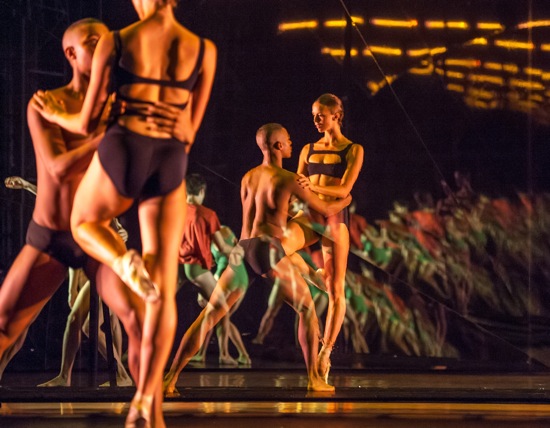Wayne McGregor’s “Tree of Codes” turns the Park Avenue Armory into a 21st-century phantasmagoric playground.
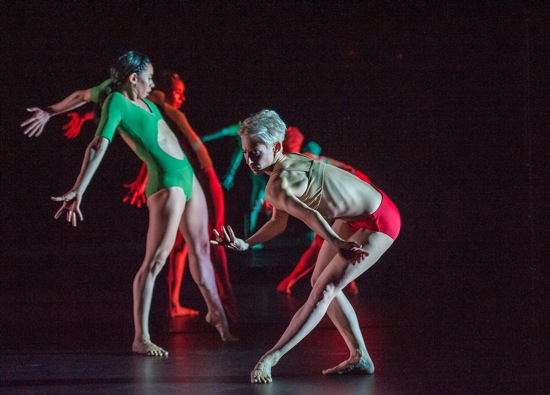
Fukiko Takase (L), Daniela Neugebauer, and virtual selves in Tree of Codes at the Park Avenue Armory. Photo: ©Stephanie Berger.
Why when I meditate on Tree of Codes, the dance-and-design spectacle on view at the Park Avenue Armory, do I flash back almost 150 years to the spectacle-extravaganza, The Black Crook? The two productions have in common little but their desire to astonish. The Black Crook opened in 1866 at Niblo’s Garden, which occupied a block on Lower Broadway just across Prince Street from today’s Dean and Delucca. The mammoth building housed a theater that seated over 3000, reception rooms, a bar room, a restaurant, a concert hall, and, oh yes, a garden. The boards of its stage slid on grooves. Trapdoors could open to allow whole scenes to sink into the basement or rise from it. All by means of what New York Times writer airily described as “simple machinery” (that is, a sweating backstage crew hauling on ropes or turning wheels).
Here’s a fevered response by a New-York Tribune writer to the scene that ended Act II: “A vast grotto is herein presented, extending into an almost measureless perspective. Stalactites descend from the arched roof. A tranquil and lovely lake reflects the golden glories that span it like a vast sky.” And to add to the charm of the scene are “the sprites of the ballet, who make the scene luxuriant with their beauty.”
Flash forward to 2015. Entering the former Seventh Regiment Armory, which almost fills a city block, you pass through a hall and reception rooms dating from the second half of the nineteenth century: electrified chandeliers, elaborately carved woodwork, Tiffany class panels, portraits of military men. The great vaulted hall where the regiment once drilled is now home to large-sized cultural events presented by a non-profit organization. And for Tree of Codes, the hall has been transformed into a dazzling array of optical and aural effects inspired by the eponymous book by Jonathan Safran Foer. British choreographer-director Wayne McGregor has read Tree of Codes. So has the Icelandic visual artist Olafur Eliasson, currently based in Berlin. So has Jamie xx, British composer, performer, re-mix artist, and producer. So have the dancers—six of them members of the Paris Opera Ballet and nine of them members of Company Wayne McGregor. In addition, each of them created movement based on their reactions to the pages of the book—material that McGregor then selected and organized.
More about that book. It’s the literary art object that Safran Foer created by cutting little squares and rectangles out of pages from many manuscripts of Bruno Schulz’s short-story collection The Street of Crocodiles and assembling and layering pages selectively to tell another story—as Safran Foer puts it—within Schultz’s story. (for photos and an explanation click on: https://www.youtube.com/watch?v=dsW3Y7EmTlo). The book’s presentation of reading as a three-dimensional process affected the collaborators of Tree of Codes in terms of structural processes, rhythms, as well as the additional crucial contributions from Rob Halliday (credited with “Lighting Realization”).
The folks who created The Black Crook used 19th-century theatrical machinery and sets to create an illusory world. McGregor, Eliasson, Jamie xx, and Halliday have recourse to the wonderworld of digitization and more, e.g. highly controllable electrical illumination, plus reflecting or transparent surfaces realized on a scale that would not have been possible in 1866. The creators propose no narrative, unlike The Black Crook with its awkward Faustian tale that limped over five hours with lengthy breaks for refreshment. Their goal seems to have been to be alter our perception over an intermissionless hour in order that we may see images within images, or images duplicating themselves into apparent infinity. The effects are spectacular, fantastic. Yet while the world changes around the splendid dancers, they perform their strenuous actions bounded by the perimeters of the usual floor, apparently undistracted by their unstable virtual terrain.
The real and the illusory tango together as the audience is walking to the tiers of seats. When people pass along the sides of the immense space, each one’s moving silhouette is cast onto the wall, split into a rainbow of virtual selves. When the traffic increases, large bright-colored people pass and briefly blend with smaller ones (this depends on a person’s distance from the screen). Of course, spectators catch onto this, stop, take photos, do little routines, and ask friends to snap them while they wave their arms; their obedient images copy them. Eventually, the lights dim, and the sound score begins with piano and a light, clacking percussion that sounds a bit like applause.
There’s no way you can see in the choreography the processes that the dancers and McGregor went through. Performers come and go, mingle in duets or trios in which they snake around each other. They spin through, rush past, reappear in different costumes. Even though they (notably Fukiko Takase) may decompose on the floor, the style privileges limbs. The dancers slash and jab and swing their arms and arrow-straight legs around, and those appendages yank them into turns or engagements with others, or cant them off balance.
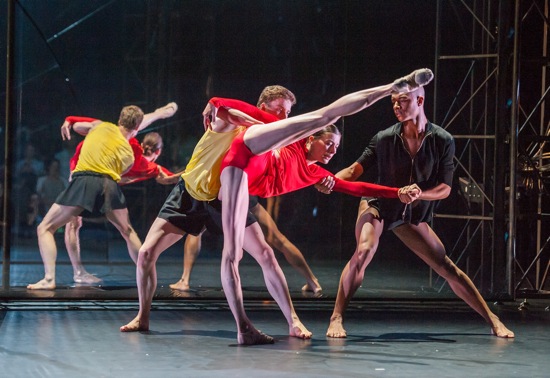
Tree of Codes‘ Travis Clausen-Knight (in yellow) and Louis McMiller assist Marie-Agnès Gillot. Photo: ©Stephanie Berger
Somewhere in the middle of things, what I presume are the six dancers of the Paris Opera Ballet appear together in identical duets: (by rank) étoiles Jérémie Bélingard and Marie-Agnès Gillot, sujets Sébastien Bertaud and Julien Meyzindi, coryphée Lydie Vareilhes, and member of the quadrille Lucie Fenwick. How do I recognize them? The women wear pointe shoes for this sequence, and the partnering is slightly more conventional. At other times, they may mix or share the stage with those in Compagnie Wayne McGregor. I can admire Catarina Carvalho and James Pett dancing together or follow Daniela Neugenbauer’s white-blond cap of hair as she whips into action or admire Louis McMiller partnering Lucie Fenwick. Travis Clausen-Knight, Alvaro Dule, Anna Nowak, Jessica Wright: I know I saw and admired you.
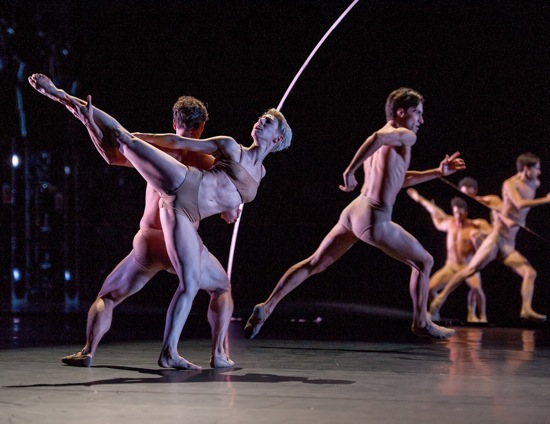
Tree of Codes: Jérémie Bélingard (partly hidden) with Daniela Neugebauer; Sébastien Bertaud races by. Photo: ©Stephanie Berger.
However, anyone watching this dance has to concede that it’s not a competition between the performers and Eliasson’s stunning visual concept; the dancers collaborate in powering his eye-catching illusions. When two of them perform a pas de deux and you see their mirrored replicas behind them getting smaller and smaller until they vanish, you don’t pay close attention to the choreography. Sometimes, too, you have to realize that you’re not seeing, say, two pairs, two trios, and a solo figure, you’re seeing six dancers and their reflections. When Bélingard, all in dark blue, dances alone in a suddenly gray world, you may forget what a fine and interesting dancer he is while wondering, “what are those things behind him that look like dirty icebergs, and what’s causing them?”
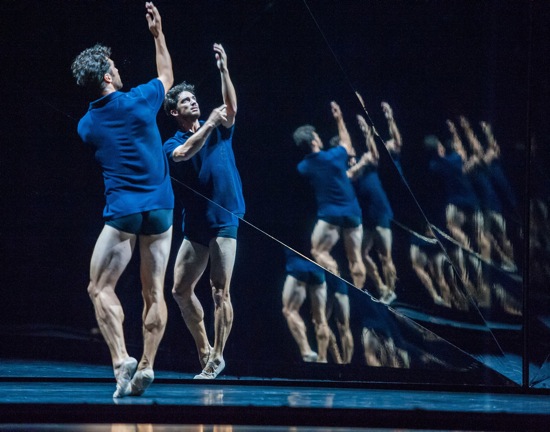
Jérémie Bélingard confronts himselves in Tree of Codes at the Park Avenue Armory. Photo: ©Stephanie Berger.
The effects keep growing and multiplying. What had looked like an immense metal fence suspended above the performing area, with two huge circles part of its design, acquires unforeseen possibilities when it descends. Those rings rotate, red lights revealing surprisingly wide rims and interior disks that can appear and disappear. And what had seemed a flat surface can bend in the middle—or seem to bend. The dancers’ playground, in other words, becomes brighter and more complex; and they change costumes to adjust the color palette.
At times, shards of what might be dramas emerge, but flicker away. You begin to think that one man’s dashing through could be affecting an electronic progression, rather than conveying that he’s late for work. A singing voice doesn’t so much express emotions as perhaps cause a rearrangement of Tree of Codes’ tectonic plates. If you’re tempted to consider a deeper level to this 21st-century spectacle-extravaganza, it might be an exploration of the many ways in which we experience bodies and their transformative scenarios today: Skype, edited iPhotos, cosmetic surgery, et al. Even we spectators are sometimes an unstable presence in Tree of Codes, reflected back onto what we’re watching—our dim, slightly wobbly images much more unreal than the vivid dancers’ reflections.
As that 1866 journalist wrote: “A vast grotto is herein presented, extending into an almost measureless perspective.”
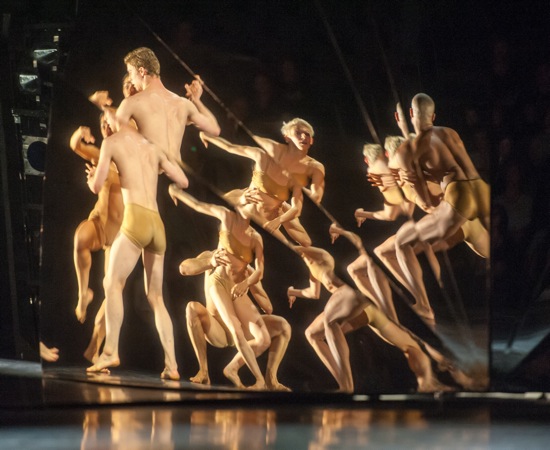
Infinitely receding dancers in Tree of Codes. Visual Concept by Olafur Eliasson, choreographed and directed by Wayne McGregor. Photo: ©Stephanie Berger

